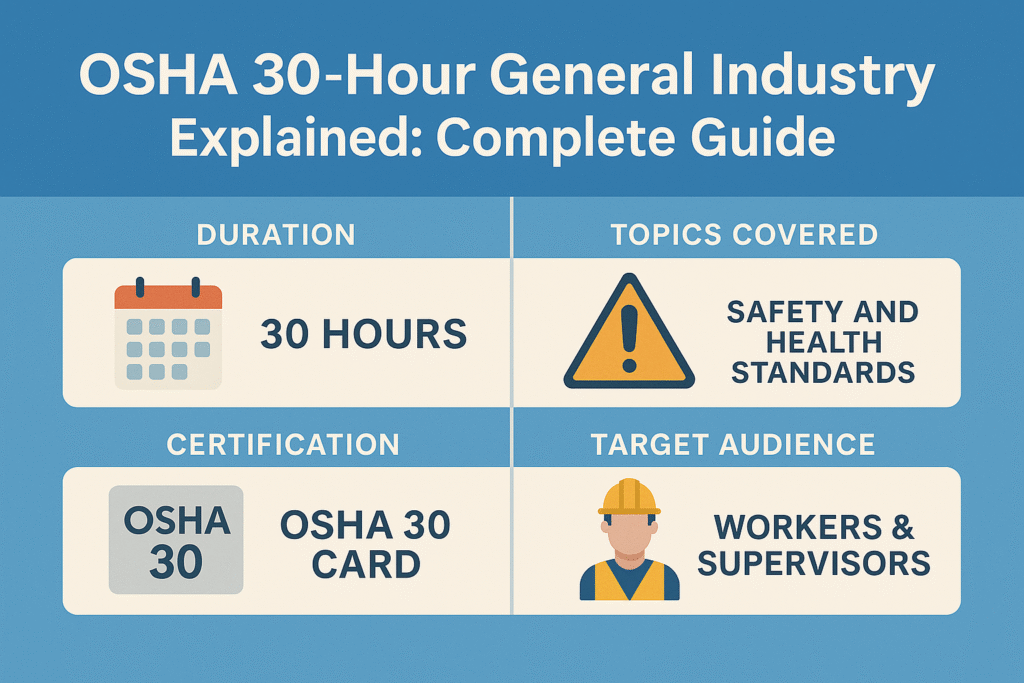
OSHA 30 Hour General Industry Explained: Complete Guide
In today’s workplaces, safety is not just a responsibility—it’s a legal requirement. One of the most recognized training programs in the United States is the OSHA 30-Hour General Industry Training. This program equips workers and supervisors with in-depth knowledge of workplace hazards, rights, and responsibilities under OSHA standards.
What is OSHA?
The Occupational Safety and Health Administration (OSHA) was established in 1970 under the US Department of Labor. Its mission is to ensure safe and healthy working conditions by setting and enforcing standards and providing training.
Overview of OSHA 30-Hour Training
The OSHA 30-Hour General Industry course is a comprehensive safety training program designed for supervisors, managers, and employees with safety responsibilities in industries outside of construction, such as:
- Manufacturing
- Warehousing
- Healthcare
- Oil and Gas
- Service industries
It provides a deeper understanding of workplace hazards compared to the OSHA 10-Hour course.
Difference Between OSHA 10-Hour and OSHA 30-Hour
| Feature | OSHA 10-Hour | OSHA 30-Hour |
|---|---|---|
| Duration | 10 hours (basic) | 30 hours (advanced) |
| Audience | Entry-level workers | Supervisors, managers, safety staff |
| Depth | Basic awareness | Detailed safety and compliance |
| Certification | OSHA 10 Card | OSHA 30 Card |
Who Should Take OSHA 30-Hour General Industry?
- Safety supervisors and coordinators
- Department managers
- Employees responsible for compliance
- Workers in high-risk environments
- Anyone seeking a competitive advantage in the job market
Eligibility and Entry Requirements
- No strict prerequisites.
- Suitable for workers and supervisors in non-construction industries.
- Basic English proficiency is required.
Course Duration and Study Hours
- Duration: Minimum 30 hours of training (usually spread over 4–5 days).
- Delivery: Classroom or OSHA-authorized online platforms.
- Study Hours: Can be flexible with online learning.
Course Structure Overview
The OSHA 30-Hour General Industry course covers mandatory, elective, and optional topics.
Mandatory Topics in OSHA 30-Hour General Industry
- Introduction to OSHA
- Workers’ rights and employer responsibilities.
- How to file complaints.
- Walking and Working Surfaces
- Preventing slips, trips, and falls.
- Exit Routes, Emergency Action Plans, Fire Prevention
- Safe evacuation procedures.
- Fire extinguisher basics.
- Electrical Safety
- Common hazards and safe practices.
- Personal Protective Equipment (PPE)
- Selecting, using, and maintaining PPE.
- Hazard Communication (HAZCOM)
- Understanding Safety Data Sheets (SDS).
- Labeling systems and chemical safety.
Elective and Optional Topics
Elective subjects may include:
- Lockout/Tagout (LOTO)
- Machine guarding
- Ergonomics
- Bloodborne pathogens
- Workplace violence prevention
Delivery Modes of OSHA 30-Hour Training
- Classroom Training – Instructor-led.
- Online Training – Through OSHA-authorized providers.
- Blended Learning – Mix of both.
Assessment and Certification
- No final exam requirement by OSHA.
- Training providers may use quizzes or assessments.
- Upon completion, learners receive an official OSHA 30 Card, issued by the U.S. Department of Labor.
Validity of OSHA 30-Hour Card
- The OSHA 30 Card does not expire, but many employers recommend refreshing training every 3–5 years.
Cost of OSHA 30-Hour Training
- Classroom Training: $400–$600
- Online Training: $150–$250
- Costs vary by provider and location.
Benefits of OSHA 30-Hour Certification
- Enhances employability.
- Provides compliance knowledge.
- Helps prevent workplace accidents.
- Increases worker confidence.
OSHA 30-Hour General Industry vs OSHA 30-Hour Construction
| Feature | General Industry | Construction |
|---|---|---|
| Focus | Manufacturing, healthcare, warehousing | Building and construction sites |
| Hazards Covered | Electrical, HAZCOM, ergonomics | Fall protection, scaffolding, cranes |
| Audience | Supervisors in non-construction | Foremen, site supervisors |
OSHA 30-Hour vs NEBOSH IGC vs IOSH Managing Safely
| Feature | OSHA 30-Hour | NEBOSH IGC | IOSH Managing Safely |
|---|---|---|---|
| Recognition | USA-focused | Global | UK/global entry-level |
| Duration | 30 hours | 10–15 days | 3–4 days |
| Level | Intermediate | Advanced (Level 3) | Introductory/Management |
| Certificate | OSHA 30 Card | NEBOSH IGC Certificate | IOSH Certificate |
Industries That Require OSHA 30-Hour General Industry
- Healthcare
- Oil and Gas
- Chemical Manufacturing
- Warehousing and Logistics
- Utilities and Service industries
Career Opportunities After OSHA 30-Hour Training
Roles may include:
- Safety Coordinator
- HSE Officer
- Compliance Specialist
- Safety Trainer
Average Salaries After OSHA 30-Hour Certification
- USA: $50,000–$75,000/year
- Middle East (with OSHA + NEBOSH): $1,500–$3,500/month
- India: ₹5–8 LPA (with added qualifications)
Case Studies and Success Stories
- Manufacturing Plant: Reduced accidents by 20% after supervisors completed OSHA 30 training.
- Healthcare Facility: Improved compliance with OSHA standards, reducing penalties.
Common Myths About OSHA 30-Hour General Industry
- “It’s only for managers.” – False; workers can also benefit.
- “The card expires.” – No, it’s valid for life.
- “It guarantees a job.” – It boosts employability but doesn’t guarantee jobs.
Tips to Succeed in OSHA 30-Hour Training
- Choose an OSHA-authorized provider.
- Take notes during sessions.
- Apply learning in real workplace scenarios.
- Refresh knowledge every few years.
Future Pathways After OSHA 30-Hour Certification
- NEBOSH IGC – for global recognition.
- OSHA Outreach Trainer Program – for those wanting to train others.
- Advanced safety diplomas for career growth.
Conclusion
The OSHA 30-Hour General Industry course is more than training—it’s an investment in safety and career growth. With its comprehensive coverage of hazards, legal responsibilities, and practical solutions, it helps employees and supervisors create safer, compliant, and more productive workplaces.
If you’re serious about a career in safety in the U.S. or industries operating under OSHA standards, this is a must-have certification.
“📘 Download OSHA 30-Hour General Industry – Complete Guide 👉 Click Here”
OSHA 30-Hour General Industry vs Construction: Which One to Choose?
What is New in OSHA Guidelines 2025: A Quick Summary for Safety Officers
OSHA Monthly Safety Topics 2025
OSHA and IOSH Officer Salary in Dubai
Check your OSHA Certificate is Original or Fake?
FAQs
1. Who needs OSHA 30-Hour General Industry?
Supervisors, managers, and safety staff in non-construction industries.
2. Does the OSHA 30 Card expire?
No, it’s valid for life, though refreshers are recommended.
3. Can I take OSHA 30 online?
Yes, but only through OSHA-authorized providers.
4. What is the cost of OSHA 30-Hour training?
Between $150 and $600 depending on provider.
5. What’s next after OSHA 30?
You can pursue NEBOSH IGC, IOSH, or OSHA Trainer programs.
























